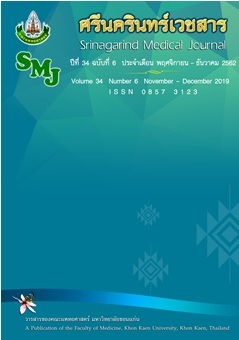Whole Grain Essential Oil Reduces Blood Pressure by Increasing Nitric Oxide Level and Alleviating Oxidative Stress in Nitric Oxide Deficient Hypertensive Rats
Keywords:
Whole grain essential oil; Hypertension; L-NAME, Nitric oxide; Oxidative stress, น้ำมันรำข้าวกล้อง; ความดันเลือดสูง; แอลเนม; ไนตริกออกไซด์; ภาวะเครียดออกซิเดชันAbstract
Background and Objective: Hypertension is the important risk factor for cardiovascular disease (CVD). Oxidative stress is associated with the development of hypertension. Consumption of dietary antioxidants appears to decrease blood pressure, improve endothelial function and reduce the risk of CVD. Whole grain essential oil (WEO) possesses strong antioxidant property and has been reported to reduce the CVD risk. This study aimed to evaluate the antihypertensive property of WEO using a rat model of nitric oxide (NO) deficiency hypertension.
Methods: Male Sprague-Dawley rats received a nitric oxide synthase (NOS) inhibitor, Nω-nitro-L-arginine methyl ester (L-NAME) at dose of 50 mg/kg/day in drinking water for 3 weeks. WEO (1 or 2 ml/kg/day) were intragastrically administered during L-NAME administration.
Results: A markedly increased arterial blood pressure, elevated hindlimb vascular resistance and decreased hindlimb blood flow were found in L-NAME-induced hypertensive rats (p < 0.05). Enhanced vascular superoxide production, increased oxidative stress and decreased NO metabolites (NOx) levels were also found in L-NAME-treated rats. Concurrent treatment with WEO resulted in a dose-dependent improved hemodynamic status and significantly reversed the L-NAME-induced oxidative stress and suppression of NO production (p < 0.05).
Conclusions: The data revealed that WEO is an effective antioxidant that helps to reduce high blood pressure. The antihypertensive effects of WEO are likely to be mediated by increasing antioxidant activities and restoring NO bioavailability.
References
2. Heitzer T, Schlinzig T, Krohn K, Meinertz T, Munzel T. Endothelial dysfunction, oxidative stress, and risk of cardiovascular events in patients with coronary artery disease. Circulation 2001; 104: 2673-8.
3. Michel T, Vanhoutte PM. Cellular signaling and no production. Pflugers Arch 2010; 459: 807-16.
4. Nakmareong S, Kukongviriyapan U, Pakdeechote P, Donpunha W, Kukongviriyapan V, Kongyingyoes B, et al. Antioxidant and vascular protective effects of curcumin and tetrahydrocurcumin in rats with l-name-induced hypertension. Naunyn Schmiedebergs Arch Pharmacol 2011; 383: 519-29.
5. Touyz RM. Reactive oxygen species, vascular oxidative stress, and redox signaling in hypertension: What is the clinical significance? Hypertension 2004; 44: 248-52.
6. Boeing H, Bechthold A, Bub A, Ellinger S, Haller D, Kroke A, et al. Critical review: Vegetables and fruit in the prevention of chronic diseases. Eur J Nutr 2012; 51: 637-63.
7. Liang Y, Gao Y, Lin QL, Luo FJ, Wu W, Lu Q, et al. A review of the research progress on the bioactive ingredients and physiological activities of rice bran oil. Eur Food Res Technol 2014; 238: 169-76.
8. Rao YPC, Sugasini D, Lokesh BR. Dietary gamma oryzanol plays a significant role in the anti-inflammatory activity of rice bran oil by decreasing pro-inflammatory mediators secreted by peritoneal macrophages of rats. Biochem Biophys Res Commun 2016; 479: 747-52.
9. Nakmareong S, Kukongviriyapan U, Pakdeechote P, Kukongviriyapan V, Kongyingyoes B, Donpunha W, et al. Tetrahydrocurcumin alleviates hypertension, aortic stiffening and oxidative stress in rats with nitric oxide deficiency. Hypertens Res 2012; 35: 418-25.
10. Kukongviriyapan U, Kukongviriyapan V, Pannangpetch P, Donpunha W, Sripui J, Sae-Eaw A, et al. Mamao pomace extract alleviates hypertension and oxidative stress in nitric oxide deficient rats. Nutrients 2015; 7: 6179-94.
11. Islam MS, Yoshida H, Matsuki N, Ono K, Nagasaka R, Ushio H, et al. Antioxidant, free radical-scavenging, and nf-kappab-inhibitory activities of phytosteryl ferulates: Structure-activity studies. J Pharmacol Sci 2009; 111: 328-37.
12. Shin SY, Kim HW, Jang HH, Hwang YJ, Choe JS, Kim JB, et al. Gamma-oryzanol suppresses cox-2 expression by inhibiting reactive oxygen species-mediated erk1/2 and egr-1 signaling in lps-stimulated raw264.7 macrophages. Biochem Biophys Res Commun 2017; 491: 486-92.
13. Raghuvanshi R, Chandra M, Mishra A, Misra MK. Effect of vitamin e administration on blood pressure following reperfusion of patients with myocardial infarction. Exp Clin Cardiol 2007; 12: 87-90.
14. Ekhlasi G, Zarrati M, Agah S, Hosseini AF, Hosseini S, Shidfar S, et al. Effects of symbiotic and vitamin e supplementation on blood pressure, nitric oxide and inflammatory factors in non-alcoholic fatty liver disease. EXCLI J 2017; 16: 278-90.
15. Boshtam M, Rafiei M, Sadeghi K, Sarraf-Zadegan N. Vitamin e can reduce blood pressure in mild hypertensives. Int J Vitam Nutr Res 2002; 72: 309-14.




